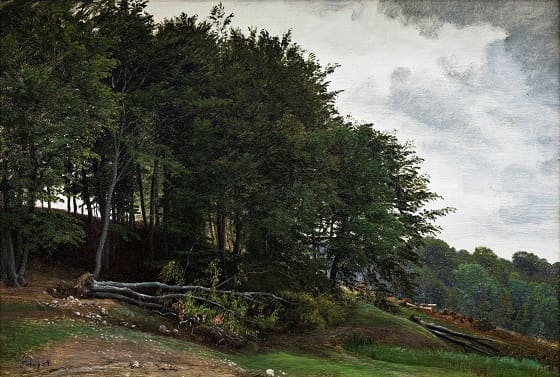P. C. Skovgaard
Forested hills, 1864
Oil on canvas, 36 x 52 cm.
Inventory number: 0149NMK
Acquired in 1876. Bestowed to the museum in 1908
A group of beech trees rise majestically atop a hill in a densely wooded forest. A toppled tree occupies a central position in the foreground, while grey clouds fan out over an otherwise bright sky in the background. The beech tree became a central symbol of Danish nature and patriotic sentiments in the 1800s and was included by Danish poets in patriotic songs such as the national anthem Der er et yndigt land (1819) by Adam Oehlenschläger and H.C. Andersen’s I Danmark er jeg født (1850). P.C. Skovgaard’s bright and harmonic depictions of the Danish beech forests also betrays a nationalist sentiment. In this painting for example, the toppled beech tree is featured as a central component in the composition. In 1864, the same year Skovgaard completed this painting, Denmark suffered a massive blow to its national pride and identity when it was forced to cede the Duchies of Schleswig, Holstein and Saxe-Lauenburg to Prussia and Austria.
Peter Christian Skovgaard (1817-1875)
In Denmark, Skovgaard, along with his artist colleague, J. Th. Lundbye, became one of the most significant National Romantic landscape painters of the Golden Age. For a number of years, he was a professor at the Academy of Art in Copenhagen. Among Skovgaard’s sources of inspiration were Flemish Baroque landscape painters such as Jacob Ruysdael and the French artist Claude Lorrain’s timeless Arcadian landscapes. He mastered both the smaller formats with realistic, impasto depictions of nature and bigger, monumental and detailed compositions. The artist’s favoured subject matter was the Danish beech forest, which he painted throughout his life in countless variations from regions all across the country. Skovgaard’s artistic legacy was primarily carried on through his sons, Joakim and Niels.


